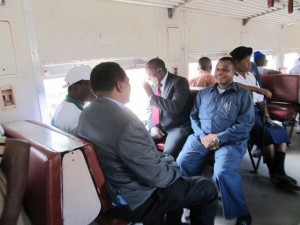China helps Tazara Railway again
Tanzania, Zambia, and China have agreed on 12 new projects to help improve the performance of the Tanzania-Zambia Railway (Tazara) line which has become dilapidated over recent years. Cargo has dropped from 1.2 million tonnes in 1992 to 330,000 tonnes in 2011-12. Passengers are down from its original 3 million capacity to 790,000 in the same period. China is providing £42 million for rehabilitation of 42 passenger coaches, 6 locomotives and rescue and lifting equipment.
Dar es Salaam commuting rail service

Minister of Transport, Dr. Harrison Mwakyembe (centre waving hand) accompanied by officials from the Transportation Authority of Land Surface and Marine (Sumatra) on the first commuter train. Photo isaackin.blogspot
Tanzania’s first ever commuter rail service was launched on 29th October. The first route (operated by Tanzania Railways Ltd TRL) covers 20km between Ubungo-Maziwa and the central railway station, while the second is operated by Tazara and covers 25km between Mwakanga (Pugu area) and the Tazara station. Initially a single train is operating on each line, shuttling to and fro during the morning and evening rush hours. A one-way ticket costs 400TShs (about £0.15), and just 100TShs for pupils, comparing favourably to daladala fares which range between 500 shillings and 1,000 shillings depending on the journey.
Inaugurating the new service, Dr Harrison Mwakyembe said TSh6 billion (£2.3 million) had been spent renovating train carriages and railway infrastructure for the TRL line while about TSh800 million (£0.8 million) was spent repairing the Tazara tracks. He thanked TRL officials for their decision to forgo purchase of brand new railcars in favour of renovating old ones which allowed the project to remain within budget.
As of December the government has stopped issuing licences to private companies that operate small commuter buses (daladalas) in Dar es Salaam, as part of its plan to replace them with much larger buses under a government-managed rapid transit system (DART) (see TA 98).
The Dar – Kigoma – Mwanza railway line
This line lost 83 kms of track in the floods last year and then had to cope with the disastrous contract with an Indian management company which eventually had to be terminated. A very limited service is now being offered. This line promises to be the Minister’s biggest headache.
Major new ports and railway
The biggest project being planned by Tanzania’s Ministry of Transport is the construction of a new port at Mwambeni Bay, Tanga. It is part of a grand project to develop an alternative sea route for Uganda and other land-locked countries such as Malawi, Zambia, Rwanda, Burundi, Uganda and the Democratic Republic of Congo, which have been depending on the overcrowded port of Mombasa. The project, a joint effort with Uganda, would include a new railway from Arusha to Musoma and a new port on the Ugandan side of Lake Victoria. Freight would be conveyed from Musoma dock by ferry to Port Bell pier – about 350 kilometres inside Uganda. A rail connection runs via Tororo to Gulu – nearly 600 kilometres on the Pakwach branch. North Gulu. A new line of roughly 250 kilometres would be constructed to Juba, and a further 550 kilometres to the Wau railhead in Southern Sudan. President Museveni of Uganda has repeatedly said that Musoma port was the “lifeline” of Uganda’s dreams.
A feasibility report prepared by UK-based consultants United Research Services recommended the construction of the new Tanga port because the present capacity would hit its maximum pressure in 2016. Although the existing port could be increased to accommodate short term traffic growth, it would become very congested. The team believe that export of soda ash from the proposed project at Lake Natron would only be possible with new port facilities. However, a section of industrialists saw no logic in constructing a new port at Mwambeni as opposed to undertaking the rehabilitation of the old port.
A speaker at a Stakeholders’ meeting on this final feasibility study said that talks about the new port dated as far back as 1968, when a foundation stone was laid on the proposed site. Conservationists at the meeting demanded that the project be scrapped to preserve the Coelacanth marine park (the primordial fish that was earlier believed to have been extinct since the end of the Cretaceous period) and sea tourism.
The Minister for Transport made his position clear and assured Tanga residents that the government had not forsaken Tanga. Reacting to the alleged threat to the Coelacanth, the Minister said that government was being very cautious over the matter, noting that a very thorough feasibility study had been conducted to make sure it was on the right track.
The report caused fresh outcry from environmentalists concerned that the proposed railway extension is expected to pass through the Serengeti National Park. This is a development which environmentalists are vehemently opposing, arguing that the ecosystem would be disrupted with noisy trains passing through the wildlife sanctuary. They claimed that this was what had caused the plan to be shelved during the days of the late President Nyerere when the idea was first mooted in the late 80s.
Officials of the two countries have said the project is provisionally estimated to cost $2.7 billion, out of which $1.9 billion is for the construction of the railway line, $672.6 million for the development of Mwambeni Port and $72 million for the development of Musoma dock.
